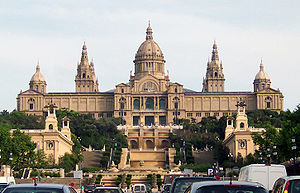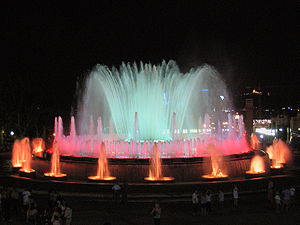- Montjuïc
-
Coordinates: 41°21′51″N 2°09′29″E / 41.36417°N 2.15806°E
Montjuïc (Catalan pronunciation: [muɲʒuˈik], alternatively spelled Montjuich) is a hill located in Barcelona, Catalonia.
Contents
Etymology
Montjuïc is translated as 'Jew Hill' in medieval Catalan, or is perhaps related to the Latin phrase Mons Jovicus ('hill of Jupiter'). The name is found in several locations in the Catalan Countries: the Catalan cities of Girona and Barcelona both have a Montjuïc, as does the island of Minorca. When written in a Spanish rather than Catalan context it is generally spelled Montjuich (this is old Catalan spelling before the orthographic reforms of Pompeu Fabra).
Description
Barcelona's Montjuïc is a broad shallow hill with a relatively flat top overlooking the harbour, to the southwest of the city centre. The eastern side of the hill is almost a sheer cliff, giving it a commanding view over the city's harbour immediately below. The top of the hill (a height of 173 metres) was the site of several fortifications, the latest of which (the Castell de Montjuïc) remains today. The fortress largely dates from the 17th century, with 18th century additions. In 1842, the garrison (loyal to the Madrid government) shelled parts of the city. It served as a prison, often holding political prisoners, until the time of General Franco. The castle was also the site of numerous executions. In 1897, an incident popularly known as Els processos de Montjuïc prompted the execution of anarchist supporters, which then led to a severe repression of the workers' struggle for their rights. On different occasions during the Spanish Civil War, both Nationalists and Republicans were executed there, each at the time when the site was held by their opponents. The Catalan nationalist leader Lluís Companys i Jover was also executed there in 1940, having been extradited to the Franco government by the Nazis.
Developments
Naturally wooded, the slopes of the Montjuïc were traditionally used to grow food and graze animals by the people of the neighbouring Ciutat Vella. In the 1890s, the forests were partially cleared, opening space for parklands. The site was selected to host the 1929 International Exposition (a World's Fair), for which the first large-scale construction on the hill began. The surviving buildings from this effort include the grand Palau Nacional, the Estadi Olímpic (the Olympic stadium), the ornate Font Màgica fountains, and a grand staircase leading up from the foot of Montjuïc at the south end of the Avinguda de la Reina Maria Cristina, past the Font Màgica and through the Plaça del Marquès de Foronda and the Plaça de les Cascades to the Palau Nacional. The Poble Espanyol, a "Spanish village" of different buildings built in different styles of Spanish architecture, also survives, located on the western side of the hill. Mies van der Rohe's German national pavilion was constructed at the foot of the hill, near the Plaça del Marquès de Foronda. It was demolished in 1930 but was rebuilt in 1988.
Also completed in 1929, the Olympic stadium was intended to host an anti-fascist alternative Olympics in 1936, in opposition to the 1936 Berlin Olympics. These plans were cancelled due to the outbreak of the Spanish Civil War. The stadium served as the home for football team Espanyol (the club left for a new stadium in Cornellà/El Prat upon its completion in 2008.)
The roads in the slopes facing the city were once the Montjuïc circuit Formula One racing circuit, hosting the Spanish Grand Prix on four occasions. However, a terrible accident in the 1975 race saw Rolf Stommelen's car crash into the stands, killing four people; as a result the Spanish Grand Prix never returned to Montjuïc circuit.
The Montjuïc was selected as the site for several of the venues of the 1992 Summer Olympics, centred around the Olympic stadium. Extensively refurbished and renamed the Estadi Olímpic Lluís Companys, the 65,000-seat stadium saw the opening and closing ceremonies and hosted the athletic events. Around it the Anella Olímpica (the "Olympic Ring") of sporting venues was built, including the Palau Sant Jordi indoor arena, the Institut Nacional d'Educació Física de Catalunya, a centre of sports science; the Piscines Bernat Picornell and the Piscina Municipal de Montjuïc, the venues for swimming and diving events respectively; and the striking telecommunications tower, designed by the architect Santiago Calatrava. Of the Piscines (swimmimg pools), the diving pool was selected as the setting for the "Slow" music video recorded in 2003 by the Australian artist Kylie Minogue.
The ornate Palau Nacional houses the Museu Nacional d'Art de Catalunya, an extensive showcase of Catalan painting and sculpture.
The top of the hill can be reached using the Funicular de Montjuïc, a funicular railway that operates as part of the Barcelona Metro, and then a gondola lift. On the eastern slope is the Miramar terminal of the Port Vell Aerial Tramway connecting Montjuïc with Barceloneta on the other side of Port Vell. Part of the slopes are covered with a well attended park and gardens. The hill is often used for amateur cycling.
The prototype metre
Main article: History of the metreIn June 1792 the French astronomers Jean Baptiste Joseph Delambre and Pierre François André Méchain set out to measure the meridian arc distance from Dunkirk to Barcelona, two cities lying on approximately the same longitude as each other and also the longitude through Paris. The fortress on Montjuïc was chosen as the reference point in Barcelona. After protracted negotiations (France and Spain were technically at war) Méchain made his measurements from the fortress on 16 March 1794.
Using this measurement and the latitudes of the two cities they could calculate the distance between the North Pole and the Equator in classical French units of length and hence produce the first prototype metre which was defined as being one ten millionth of that distance.[1] The definitive metre bar, manufactured from platinum, was presented to the French legislative assembly on 22 June 1799.
Also on the Montjuïc
- Fundació Joan Miró, a modern art museum centring around a large collection of the works of Joan Miró.
- Montjuïc Cemetery (Cementiri del Sud-Oest), a cemetery containing many of Barcelona's rich and celebrated, including Lluís Companys and his predecessor as President of Catalonia Francesc Macià, as well as artist Joan Miró, dancer Carmen Amaya and poet/priest Jacint Verdaguer. Numerous unmarked graves hold those executed in the fortress.
- The botanical gardens.
- The museum of ethnology
- The Catalan museum of archaeology (housed in the 1929 exhibition's palace of graphic arts)
- The Olympic and Sports Museum Joan Antoni Samaranch
See also
References
External links
- Montjuïc. Montjuïc Castle, Montjuïc Cemetery
- Information on the Montjuïc
- Photo guide to Montjuic
- A recreation of the Montjuich Park F1 track for Grand Prix Legends
- The Magic Fountain of Montjuic
- Montjuic/Barcelona Travel Guide
- Photos of Montjuic
- bcn.travel/montjuic
- Nature diary in English on Montjuic
Barcelona's Districts and Neighbourhoods Ciutat Vella La Barceloneta · El Gòtic · El Raval · Sant Pere, Santa Caterina i la Ribera
L'Eixample L'Antiga Esquerra de l'Eixample · La Nova Esquerra de l'Eixample · Dreta de l'Eixample · Fort Pienc · Sagrada Família · Sant Antoni
Sants-Montjuïc La Bordeta · La Font de la Guatlla · Hostafrancs · La Marina de Port · La Marina del Prat Vermell · El Poble-sec · Sants · Sants-Badal · Montjuïc · Zona Franca - Port
Les Corts Les Corts · La Maternitat i Sant Ramon · Pedralbes
Sarrià-Sant Gervasi El Putget i Farró · Sarrià · Sant Gervasi - la Bonanova · Sant Gervasi - Galvany · les Tres Torres · Vallvidrera, Tibidabo i les Planes
Gràcia Vila de Gràcia · Camp d'en Grassot i Gràcia Nova · La Salut · El Coll · Vallcarca i els Penitents
Horta-Guinardó El Baix Guinardó · El Guinardó · Can Baró · El Carmel · La Font d'en Fargues · Horta · La Clota · Montbau · Sant Genís dels Agudells · La Teixonera · La Vall d'Hebron
Nou Barris Can Peguera · Canyelles · Ciutat Meridiana · La Guineueta · Porta · La Prosperitat · Roquetes · Torre Baró · Trinitat Nova · Turó de la Peira · Vallbona · Verdum · Vilapicina i Torre Llobeta
Sant Andreu Baró de Viver · Bon Pastor · El Congrés i els Indians · Navas · Sant Andreu de Palomar · La Sagrera · Trinitat Vella
Sant Martí El Besòs i el Maresme · El Clot · El Camp de l'Arpa del Clot · Diagonal Mar i Front Marítim del Poblenou · El Parc i Llacuna del Poblenou · El Poblenou · Provençals del Poblenou · Sant Martí de Provençals · La Verneda i la Pau · La Vila Olímpica del Poblenou
Categories:- Neighbourhoods of Barcelona
- Visitor attractions in Barcelona
- Sants-Montjuïc
- Place names associated with Jews
Wikimedia Foundation. 2010.






